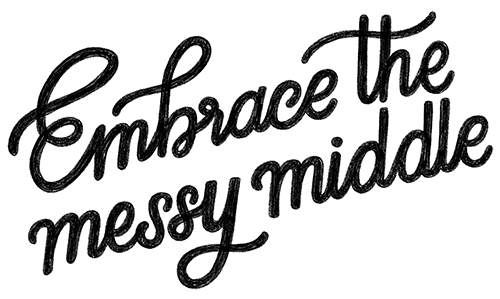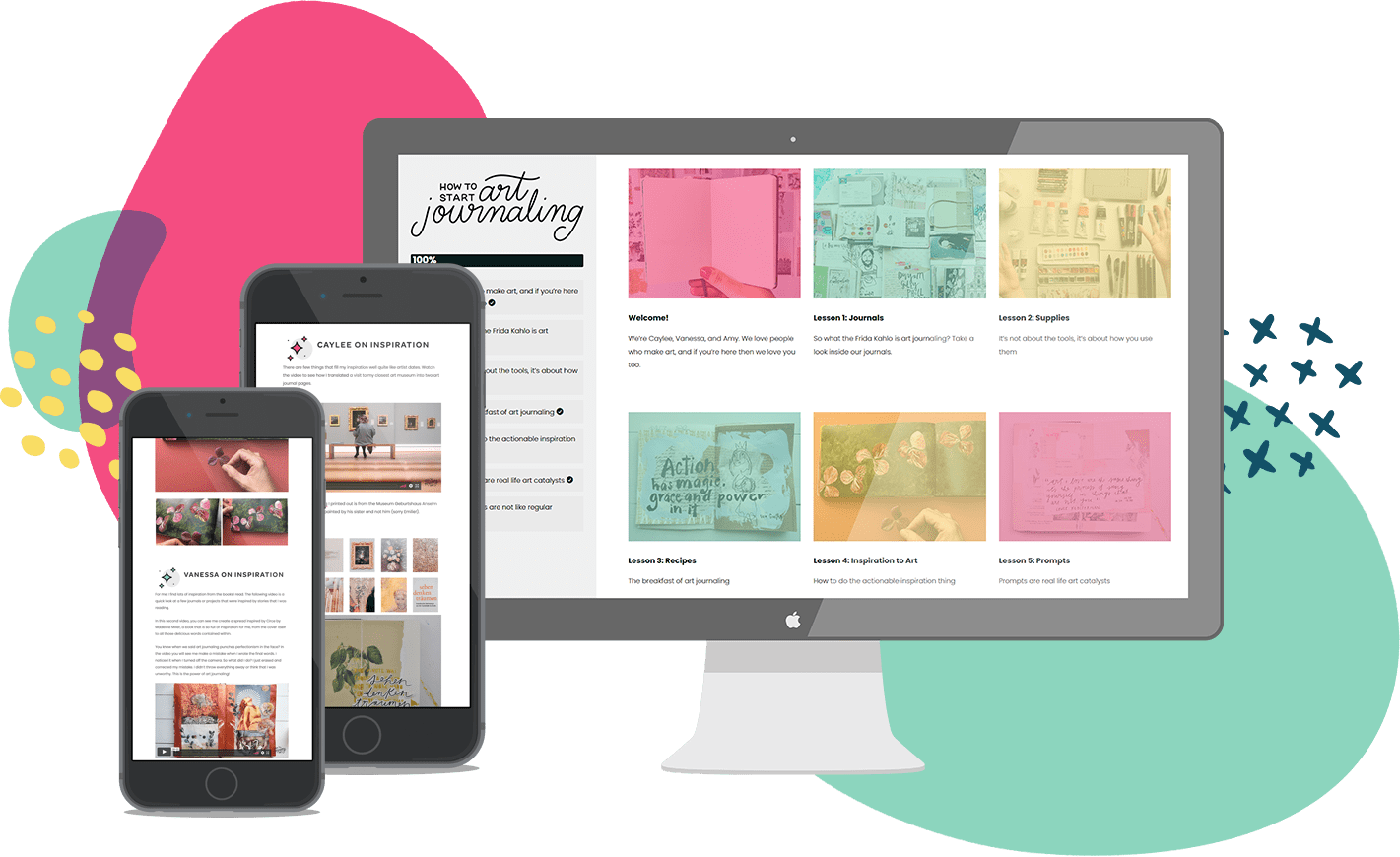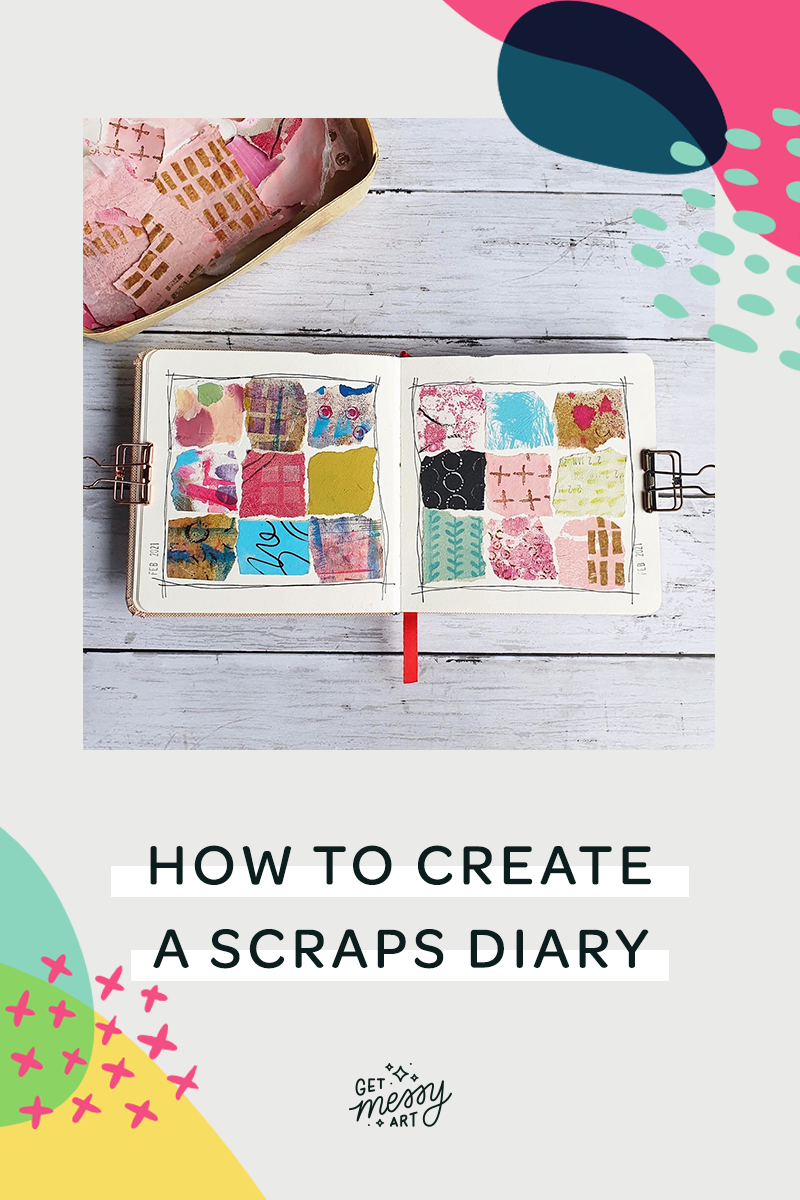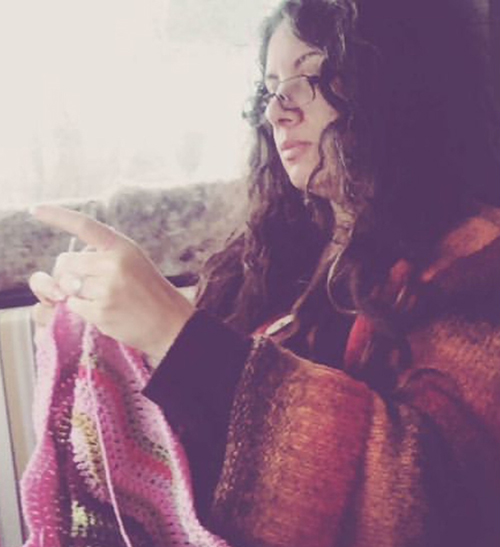In this video, Autumn Moon shares what exactly a Scraps Diary is about. She pages through her Diary and shares the spirit behind it, the guidelines, the essence, and what it means to her.

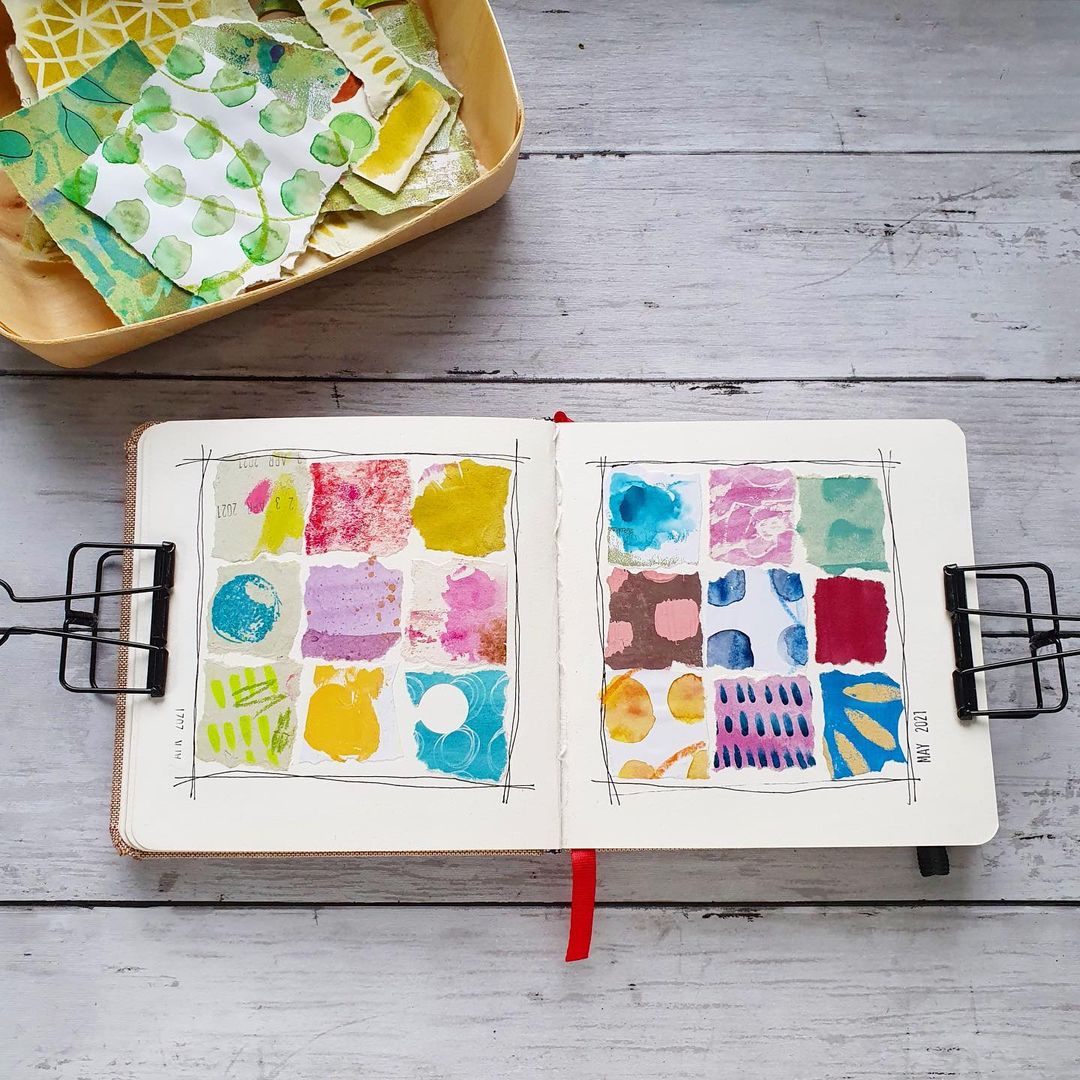
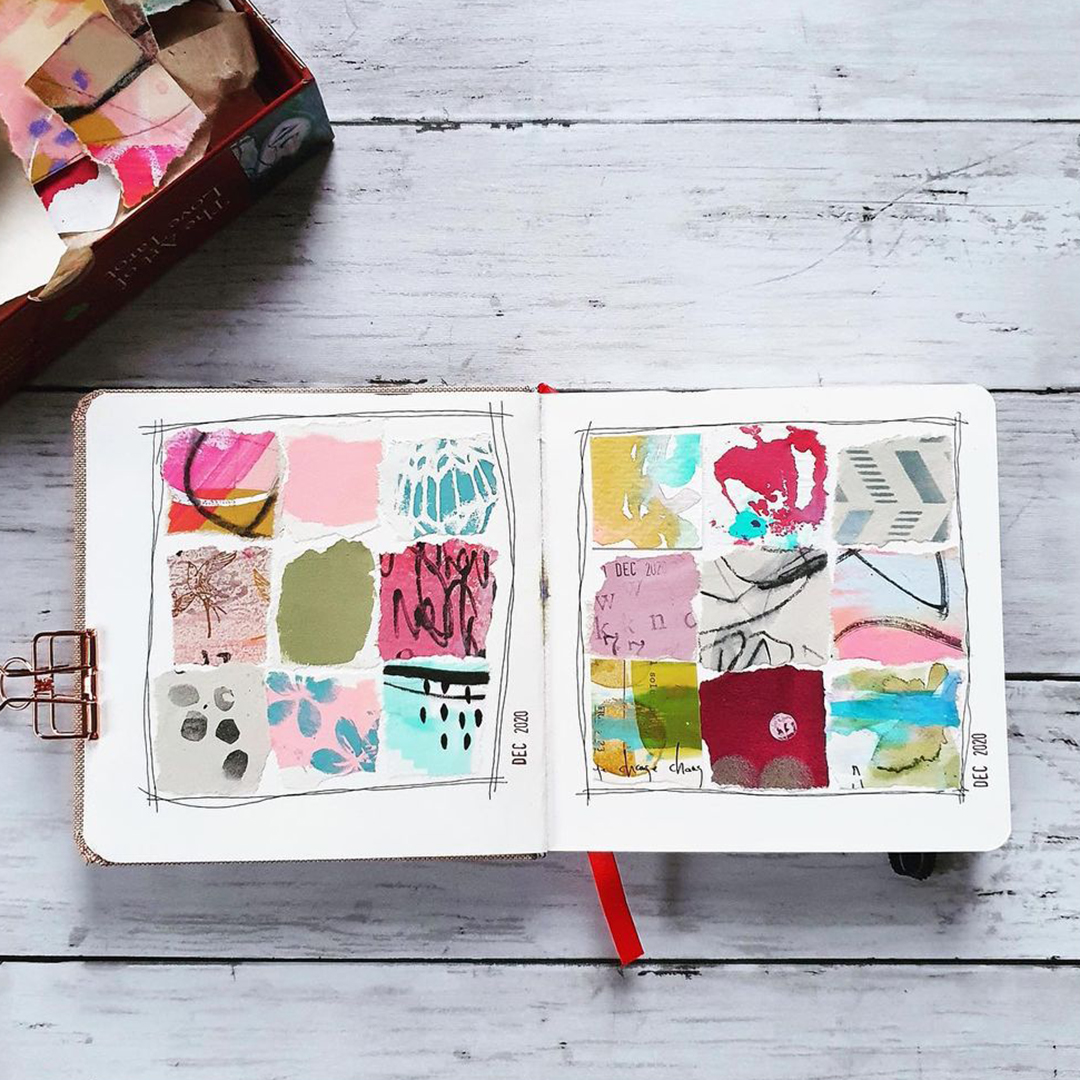
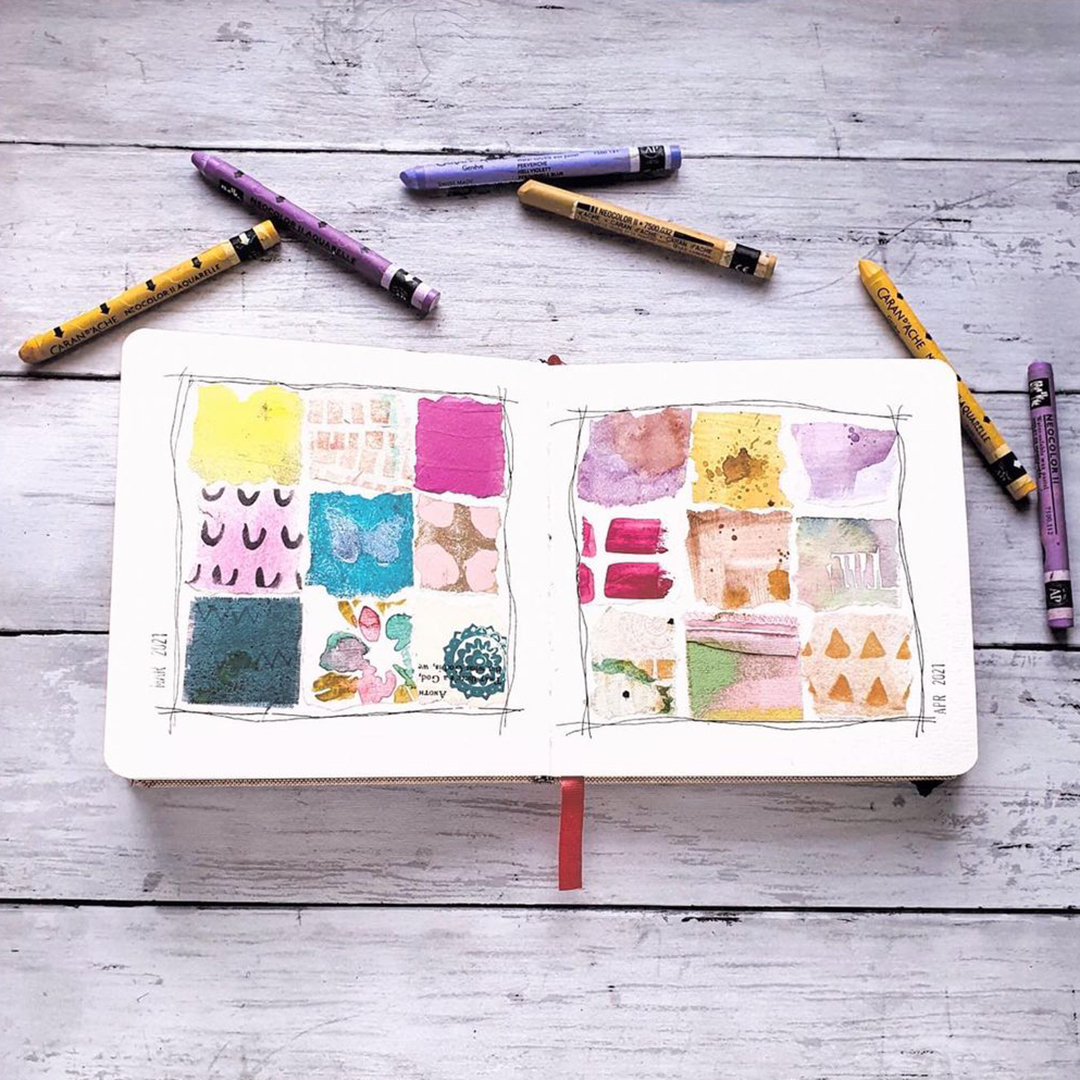
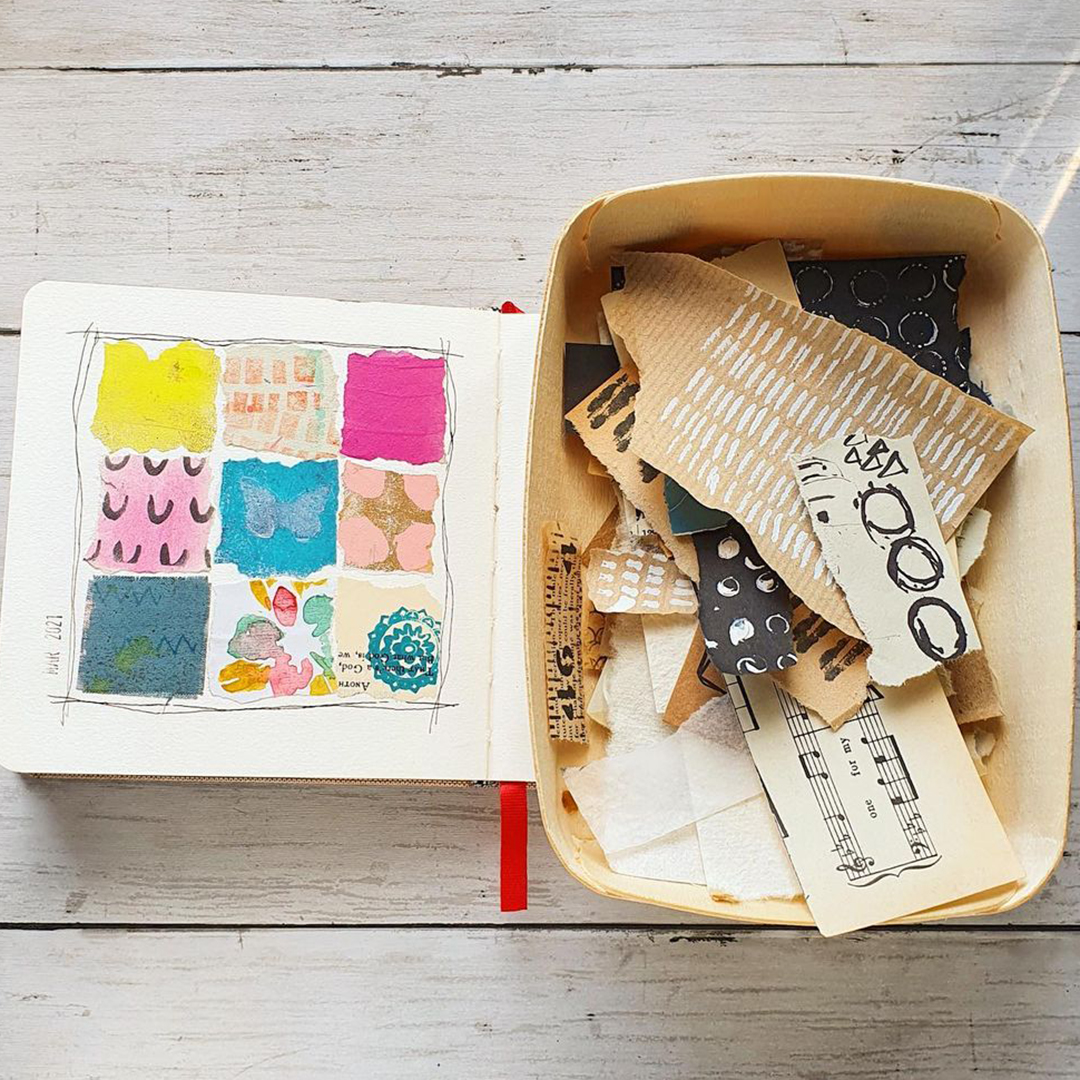
Video Transcript
Please note that this transcript has been automagically generated and is sure to contain hilarious errors:
(00:03):
Welcome everyone. So this is a video for my project scraps diary. And if you’re a follower of my account on Instagram, then you might know about this already. You might even be one of the people who’s doing, doing it yourself. So in this video, I’m going to tell you what scrap star is about. Explain the, sort of the spirit behind it, the guidelines or rules behind the the essence behind it. I’ll also tell you what scraps means to me. And if I’ve got time for, can squeeze it in, I might do my next, my next little grid and you can join in and follow along.
(00:49):
Okay. So it’s very deliberately called scraps diary rather than scraps journal. And the word journal is very broad. We can use it in so many different ways that so many different types of journals and interpretations diary can also be the creations of authority can be very different and varied, but in essence, the word diary tends to be about a record, a record of events. So just like the way you write a diary, you know, keep a diary like daily or monthly sorry, weekly where you record what has happened. That’s the same that’s, you know, that’s what a scrap start is, is a record. And in this case is a record of my art practice. So as it’s in record of, of, of events of my practice, it’s reflective. So by that, what I mean is, is what’s already passed. So I’m not creating papers to go into it because I mean, that will be like manufacturing your day.
(01:52):
So you have something interesting at the end to write about it. You don’t, you just have your day good or bad and, and interesting or not interesting. And you just write what what’s happened and your thoughts on it. So this is the same, this records what I have done already. It’s just a byproduct of my art practice. Okay. And well, and just like a diary that you write your events, it’s wonderful to look back or interesting, or, you know, nostalgic or bittersweet, but we can see what has happened, you know, year from now, years from now, and in the same way, looking back and seeing what your art practice was, because, because I’m using papers as a boat, there are a by-product of my practice. These are things I have done. So, you know, they are experiments that are created and I’ll get into later about what type of papers to use, but I can look back on this and that and think, oh, it’s really exploring this color.
(02:53):
Or I got that new stencil that month, or, you know, so on and so on. And I’m not to remember all of it because they’re not words in the, just visual triggers. I’m not necessarily going to know what in the world that was about. But I actually am because I look at it back on it. I do actually do recall quite a lot of it. It just depends how good your memories or, or how meaningful a certain square is. But I do, I can actually, I actually know this one, not so much, but I think that’s just an under paper. I know I was trying coffee some little coffee experiments there. Yeah, a little abstract that I was doing, so that’s wonderful. And that’s, I started last October, so October 20, 20 that’s November. And you know, that has only one grid for that month, but other mothers I have, I’ve got two therefore, December.
(03:48):
Yeah. So I can see back and that’s really wonderful once you have a whole collection of this I I’m, I’m just going to absolutely enjoy filling this entire book up and, and looking back and on their own. I just think they’re just beautiful. Okay. So onto the next thing okay, so the rules, okay. If you go to the app scraps diary account, which I created, because just wonderful, this thing that was just my own took off and other people found it inspiring and interesting and useful. And there are plenty of other Instagrammers, mixed media artists who, who are doing this as well. So I created this account to showcase some of these scripts diaries. Okay. Now, if you look on the bio, you’ll see there are rules. And as somebody who’s always been a non rule follower. I understand if you think, oh, roles that they’re with me, because you know, I’m 50 now and I’m no longer a rebellious teenager.
(04:50):
And I definitely was. And I’ve become older and wiser, a little wiser, hopefully, and I’ve have learned that limitations, or let’s say parameters are actually a wonderful thing. And all the freedom in the world isn’t necessarily always the best. It can be very overwhelming. It can lack direction, it can lack, focus so you know, moderation and all of that. So parameters in this case offer us a few things. So, okay. So the first rule is that it’s a grid. So there’s only like two rules for the format of the scrap story and that’s, it’s a grid. So the grid keeps it uniform and there is still a fairly there’s flexibility in this, in that the size of the grid. You know, this is, as you can see, as a three by three, it’s a little tiny about five by five inch book.
(05:50):
I do love tiny books. I just, I love square books. I just, you know, and because it’s squares that I’m using, I like the idea of putting it into a square page, but there is flexibility. You can do whatever size you want. You know, you can make a large eight by four, or maybe do five by seven, you know, anything, whatever, whatever size grid you want, you can do as long as it’s a grid. So why that uniformity? Well, just write diaries where you have the day by day or week by week, you know, there’s that format. And of course there’s all different looking diaries, but in general, you have Sunday, Monday, Tuesday, Wednesday, you know, you have a day by day, you have a week by week, you have a month by month. And there’s that idea of this is a diary.
(06:39):
This is record-keeping, this isn’t just another journal or another art journal. This isn’t just another, this isn’t just a color or bits of paper. This is a record. So that keeps it nice and uniform, and I’m going to return to that as well. Because it there’s another thing that it does. Okay. So the second rule is to keep it simple and simple. I’ve forgotten what some are by now, but I believe it’s input is non overlapped and unadorned okay. So non overlap means, as it sounds you don’t overlap the pages the scrap, sorry. So it is not a collage. Okay. Once we start overlapping that when we get into territory with, which is causing, which is just no longer becomes uniform, it becomes very creative. And we actually want to not be too creative with this, and I will expand on this in a bit as well. Okay.
(07:45):
The second one is that it’s unadorned. So again I put these lines just to sort of give the, the, the squarish sort of a containment. You can do square. Some people put lines around each scrap, so there’s a little bit of room there for how you want to do it, but again, we’re not drawing on top. We’re not adding anything extra all of that. Okay. So what does following these parameters do? Like I said, it keeps it in that diary format. It keeps it the simplicity of it keeps it stress-free and that’s really important to me in this because I do a lot of different types of mixed media. And I know a lot of you do as well. We do, we have more than one art journal. We might do actual pieces of art, say on canvas or that sort of thing.
(08:41):
We might make our own journals all sorts of little bits and bobs or two books. We do so many different things and some of them are more complex and in bold than others. But I really something in all of that, because I’ve plenty of outlets. I wanted something that was super, super about as simple as you can get. And this is what I found was as simple as you can get, it was a grid pieces of scraps and nothing else, literally nothing else. Okay. A stamping, but you know what I’m saying? And that keeps it. So like, you know, when those days, when you have nothing left, you’re just tired. When you, you can’t do any art, generally when you’ve tied it, everything you can tell you, I don’t know, you just, you’re not feeling, you know, either you’re tired or you’re stressed or whatever it is, you don’t have the time.
(09:34):
For whatever reason, you can just stick a few pieces of scraps on a page. You know, we can do that. If nothing else, just like at the Ima, Dave, you’ve got nothing left, but you can write one or two lines about your day and it’s there and you can use to come. You can look back on that. And it’s very, and it’s similar. So it’s super stress free. I’m not asking myself to be creative. I’m not asking myself to come up with anything. It’s just there. It’s there for me. And that’s one of the beauties of parameters is like, I know what needs to be done. I don’t have to think about how to arrange them. It’s a grid. I know that I don’t think about, what’s going to go over what, to, what, what will be plea? You know, it’s there now don’t get me wrong.
(10:18):
There’s a tiny amount of thought. For instance, I may not want all my pinks altogether and I might put up that, but it’s like, it’s so tiny and so simple, you know, with nine pieces of scraps, it’s like a little, little stress-free puzzle where I can just place them and move them about where I think, oh, that looks nice. I mean, very, very minimal thought, but that’s, that’s nice to arrange, you know, arrange things. It’s very meditative or that wonderful. Sun’s come out. I hope that doesn’t blow everything out. I’ll have to dark and okay. But it’s lovely to see the sun in this early spring time. Okay. So yes. So the grid and the simplicity, it keeps it as a record of your art practice rather than another art journal. We’ve got plenty of those. If this inspires you to something else, then take it further.
(11:08):
I actually have a project that was inspired by this, and that will be another video. So this gives you that permission, that permission to be relaxed, to not come up with anything super interesting to not think of layers, to not think of arrangement, to merge. I mean, you don’t even have to think of it all. It’s just putting down wherever they land, they land, you know? And that’s great. So that is a gift to oneself. You know, I’m giving them the gift of being something, doing something, which is still in my art practice. Would you still, you know, in the artists and creativity, but totally stress-free. I also believe really strongly in community and supporting one another. And one that comes out of being part of a mixed community, sorry, mixed media community is that the inspiration is amazing. It can also be overwhelming.
(12:04):
So many things that we want to try. So many techniques and mediums and styles, and just been at my age, you know, I I’m very easily I, I have no shortage of ideas. My ideas just come. Yeah, I have too many. And I just can’t do them all let alone, that’s just from my own head. Let her know when I see other people’s work, I could see the tiniest thing, tiny speck, and that could spark something within me, which is brilliant. I’m very fortunate. I’m never short of inspiration, but that can be super, super, super oval on me as well. And even if you’re not that way, it can still be overwhelming because of how much we see and, you know, that’s up to us to sort of parent down and whatever. But I, I see these sometimes like a snowball effect on Instagram where somebody comes up with something and then somebody takes that and go, oh, I was inspired by that.
(13:01):
And I made it this active and bigger and brighter and more layers. And then somebody, you know, and, and that’s wonderful, but I’m trying to think how to articulate this, but do you see where I’m coming from? Some it just can get, it’s always about more, more, more and more, and that’s not always great. And even if we are the ones that are adding more, we may not even be aware that we’re just adding too much for ourselves and paring back. I don’t think it’s our strength as a mixed media artist. You know, we love the techniques. We love the art supplies, but pairing Beck is also, I think, an important part of just daily living. You know, that moments of silence, moments of pause, moments of simplicity, somewhere, somehow part of our lives. And for me, this is that bit in my art practice.
(13:55):
So alongside this being a gift to yourself of doing something really simple and meditative and easy and quick, all of that. And stress-free, I also see it as a gift to one another. So I see it as supporting one another in that if we don’t make scraps diary anymore than it’s asking of us, we also support others to do the same that nobody feels because there’s a lot of comparison. There’s a lot of self doubt. There’s a lot of uncertainty out there in our community. Especially with new journalists of like, oh, I have to do that. I have to, you know, I can’t keep it simple. Everyone’s doing all these extra layers and everyone’s doing this and I was doing that. And I really want to encourage you to give to yourself. And, but also do you give it to everyone around you? So when you sh she has scraps diary that you’re showing, look, it doesn’t have to be any more than this, whatever it looks like for you.
(14:51):
Like I said, a larger one, some people do circles rather than a squares. That’s all in the rules, you know, that’s all permissible. And that’s where a little bit of you can come out a little bit of extra, but we’re not adding extra layers on top. We’re not add adding any Mo extra marks or any paint or dormant or anything, nothing extra out. And I, I strongly believe that really is important to add that into your practice, that simplicity, and to give that to one another, okay. I don’t want to leave with the point, but I hope I’m being clear with that. And, and, and justify why, why is his rules? Okay.
(15:32):
Okay. So let’s talk about what our scraps. So for a lot of us, we, we, we know we know what scraps, I might be self evident, but especially if you’re new or if you’ve been doing it for a long time, you may not feel like you create scraps in your art practice. So I can only tell you what what scraps are to me, my practice, and also perhaps some thoughts I might have that other people do, but I’m sure that it’s just, it’s infinite really. So my main scraps and my main scraps that ended up in my, my diary are, as you can see, I’ve got her a couple of sheets of paper. This is recycled off white sugar paper, sometimes known as construction paper. It’s super cheap. It’s not great quality, but it’s actually, it’s fairly heavy. Like, it’s not, I wouldn’t say heavy, but it’s not super thin.
(16:29):
It’s not like a copy paper. It’s a little thicker than that heavier than that. But it’s cheap. It’s not, you know I think to school children use it a lot. Okay. So I lay this down on my table and I would have my journal and I would, you know, do what I’m doing. And then on this paper would be either you know, brushing and I’ll either brush off or I’m a stamping. And I clean my stamps on on the paper. So here’s my current one. And you can see I’ve already taken bits off. I’m not sure where they’ve ended up those bits. I could use it for something else. So this is the sort of thing you normally see in my table until I’m ready to clean it, and then I’ll have a new sheet. So this is one’s become, quite become quite busy and quite muddy.
(17:27):
So I’ve cleaned stamps off I’ve. Obviously I was doing this butterflies some experiment that I was doing that the phone stamps tend to get a lot of ink in them, sort of tend to clean them off like that. I don’t tend to clean paint off because I tend to put it into the beginning of another journal page, or I might put it on a separate that will actually you know, take sort of a good amount of if it’s a good amount of paint. And then I could add more on top of that and actually make it into a future college or some little call it college photo, but sometimes I’ll do, I might just want to see quickly what the color was or what was just literally just a little bit, and I might just rub it off, but as you can see, I don’t have a whole lot of paint. It’s mostly stamps and you know, bits and pieces that have come off a little bit to think that, so the sun is shining. You can see that. All right. So, you know, it looks like a craziness and it here’s a crazy mess. It’s just, so this is what I call my under paper. Okay. So when I say under papers, this is what I mean, it’s just underneath, there’s also a second type of under paper if I can.
(18:34):
And second type of under paper is when I when I paint and I, you know, I went to protect the pages underneath, put one of these pages, as you can see, it’s got shape and I’ll spray or paint or whatever, and then end up with that. So, so in this case, I could take one of these off. I think I will. Okay. And then what I tend to do with my under papers is I have a look around and I see what, what stands out, what was perhaps the most meaningful? What just looks pretty just looks interesting to me. So I’m liking this bit here. I’ve got these complimentary colors have ended up together, so that’s really great. I’ve got this orange stamp and then this bright blue stamp underneath. So I’m really liking that.
(19:24):
I get to, so I’m keeping that upright, this leaf here and this little splash, whatever that is, some inks, let’s try it out. So don’t have any attachment to this. I can’t even know what that was though. I might just choose it because I like it. I like the color, but I do like to choose ones that I remember, oh, I was trying this on at all that you know, that it has more meaning to me, but just something that looks nice is absolutely fine because it’s still, it’s something that looks nice that I was doing that month, regardless of whether I remember why or not. Okay. So now I can still use the backs. I can use this as under paper, before general page. If it gets too small and scrappy and messy, I may just throw it away, but honestly I can find scraps everywhere.
(20:29):
Like this orangy hair. That’s still very useful. Okay. I’ll continue with that another time. Okay. So other scraps could be so this is more I would use as a college page or you’d probably launch a bits to it, but if I’ve been experimenting, I’ll probably have several of these. I don’t like rip out a little piece of that. That’s a whole page so that I was brave during when I was Jedi printing said, this is leftover paint. And that’s what I mean by, I will put this somewhere on a different bit of paper. This is actually a four and it’s P it’s white. And I can use this as a college background or I can add stenciling or stamping on top of that. But again, if I have I could either take a corner of that or I could like I said, if I have several pages, yeah.
(21:25):
I might use it. But like I said, most of these I will keep, but it is an option. That also that’s a jelly print that either didn’t work or I think I was just doing backgrounds. So that’s leftover these aren’t actually for this month. So I’m not going to include it this month. I will include that one. This is more the beginning of the month. So this is jelling printing that I did. And yeah, so that, that shows you that I was doing that that month. And I’ll take a little square of that. That’s I don’t know what that is. That’s just some leftover paint. So little bits of paper. They’re great for just rubbing off. So that’s color there. This was JD printing that I was experimenting. I was doing botanicals. And then I liked just what came off the plate to clean it off. So that, that was close to the, in the month. This was some stenciling that I was doing on black with white, just to try that out. I might use that.
(22:29):
And so not only my bringing out, taking out what is interesting and as a record of my art practice, but it’s also about finding beauty in what looks ugly. You know, a lot of people might look at this and just go, well, that’s just my under papers. Just, just throw it away. It’s just all bits of paint and standard. It’s just an utter mess. But when we look closely we can, we can find beauty and sometimes it’s by abstraction and it, you know, I can’t, I can’t really do it with my hands. You can’t see, but if it’s taking little corners of something, it’s it’s a little, sometimes a little tiny pieces of of abstract art. You know, you look at it like that little piece of air, this abstract piece whereas all around it might’ve been a mess. This was a mess all around. This was a mess all around it, but you take it just in the right spot and becomes beautiful in itself. So that’s a lovely I lovely practice as well of seeing beauty in what is usually seen as ugly or waste.
(23:40):
So under papers, and there’s two types of under papers you know, protective papers, paper in the down brush off papers experiments you’ve been doing on Gerry prints found experiments as well. Remember, we’re finding beauty in, in the ugly. So th there’s never, to me, such a thing as a failed experiment, the failure is in not experimenting. So, and any scientists, anyone with assault will tell you that it’s trying and trying and trying the gain. So anytime you are afraid to try jelly print or try something and you think, oh, what if it doesn’t turn out? There’s always something you could do with those papers. There is college colleges, there is scraps diary. You know, there is all sorts, you know, you break things down, you break what was ugly down, and this wasn’t ugly, but you break something that hasn’t really quite work, but there’s a little, little square piece.
(24:33):
This could be super interesting. And at the very least you’ve learned something you’ve learned what not to do next time. So there’s no such thing as failure and for scraps, definitely not. There’s always something you can, you can do with them. Of course it does depend on what your practice is, but if you’re a mixed media artist, if you’re an art journal, there’s always a place to to, to, to find a home. There’s always a home for a scrap. That’s my philosophy. But so you can see that some, there’s a mixture of complete organic art practice accidents not accidents, but you know, it comes organically from wiping off stamps and that sort of thing. And then they can be more specific and beautiful papers because of experiment, experiments that you did. Even ones, it worked out beautifully because if that’s what you were trying that month, and that is a record of your of your practice, but it’s lovely to have both.
(25:28):
It’s lovely to have to, again, to give yourself that gift, give yourself that permission of not having to only include beautiful things. I have a name one of my months. I, I dunno, I can’t really exactly what was happening, but I was just doing a lot. And either I was just not getting around to changing my under paper, or I was just doing so much. I think that’s what it was. I was just doing so many things that by the time I got around to changing my underpayment, he had gotten so, so muddy. And I love it. I love it. This is a true representation of that month is a true record of events early February this month. This is what happened. And I now have that, that visceral reaction and that memory of, oh, I was doing so much that month. It was like three journals going on.
(26:14):
And I was trying to keep up with challenges and all sorts. And it’s so muddy. But look at that, I think this one is just beautiful. She was a little mini artwork, abstract art there. And that one is, you know, and it doesn’t matter that ugly, but you can taking them on their own like that. If you’d seen the whole under paper, it would not being very pleasing to the eye, but on their own, they have story. And that’s what it’s about. It’s about recording your story and to do that, you have to give yourself permission to record the truth. You know, if you write in your diary today was great. When really you had an awful day. I mean, I don’t know who that benefits and it’s the same thing. Can I record the truth? And the truth is what you did, what didn’t turn out well, what you underpaid?
(26:57):
Does it look like you know, this month a little more focused and that’s a little bit of leftover of the under paper, but you can see the shift that now I’m doing very specific things. I was trying out specific and they just come out and they’re so pretty these papers. And I still, some of these are pretty as well, but I mean, they’ll pretty on the, on their own, but I love that. I love that. That is what, what happened. You know, that’s getting quite messy. Oh, I’ve done the butterfly realize that’s why I told my under paper. So that’s getting quite messy, but it was a true representation of what was going on. Okay.
(27:36):
And I find it, it can be really encouraging to yourself. When you haven’t found a worth in, in what you’ve done, that realized that he has a second life, he has a chance as, as a second or even third life that you can tear it up and make it into something else, like a scrap story. So let’s get on with making money. That’s my last one. And I’m going to, so as I said, I would choose, so this is nice. I’m going to choose nine pieces. I really liked that one. I didn’t like that one. I was trying out my pastorals off content, that one. And I sort of, I use one from the previous just to get a rough idea of, of this size.
(28:32):
Yeah. There’s nothing exact about this and he doesn’t have the briefing papers. If you don’t do this, please do it. Please rip paper. That’s so satisfying. So I get the rough size that I want. Okay. And then I can work on that as well. So I want this leave. Do I want the whole day, or do I just want, I kind of want the idea of the suggestion of the leaf rather than the whole leaf I’m going to get there. Okay. I think I’m going to speed up this part, just so just send the videos, not too long, but please don’t be fooled by that energy. Understand that this is something that I don’t rush. It’s very fast just by, you know, the project itself. It doesn’t, it doesn’t take long to record my, my day, my month. I’m usually gonna do it by weeks at the moment, but it just depends on which I have on my do one a week. Why I only do one for the month. It’s just whatever you have, it’s you, it’s your record. And that’s, what’s nice about it. It’s a diary that doesn’t, it’s undated. So you can do as many or as little as like, so I will spit it up, but yeah. To keep in mind that energy, that it’s just, it’s a quiet meditative
(29:56):
Stress-Free active team. [inaudible]
(30:48):
Okay. So I will throw most of this out, but if I, if there’s anything interesting left, I might still keep her. Okay. So I have my nine pieces and now just find where I might want them. I tend to, you know, not want all one color together, possibly. If there is one sharp edge, I will, I keep it on the, on the side. Hmm. See, that’s fine. I barely thought about that. Oh, my base in the middle. I think I like that. And Cole just, there’s a lot of pattern there and just flat colors so that round it’s it. And it’s just painful. It’s just, you know, there we are. Okay. It’s just a acoustic, I tend to start with middle. So then
(32:03):
It winds up roughly where I wanted to end up [inaudible]
(32:47):
Okay. There we are. And then screw lines, data March. I only put the month.
